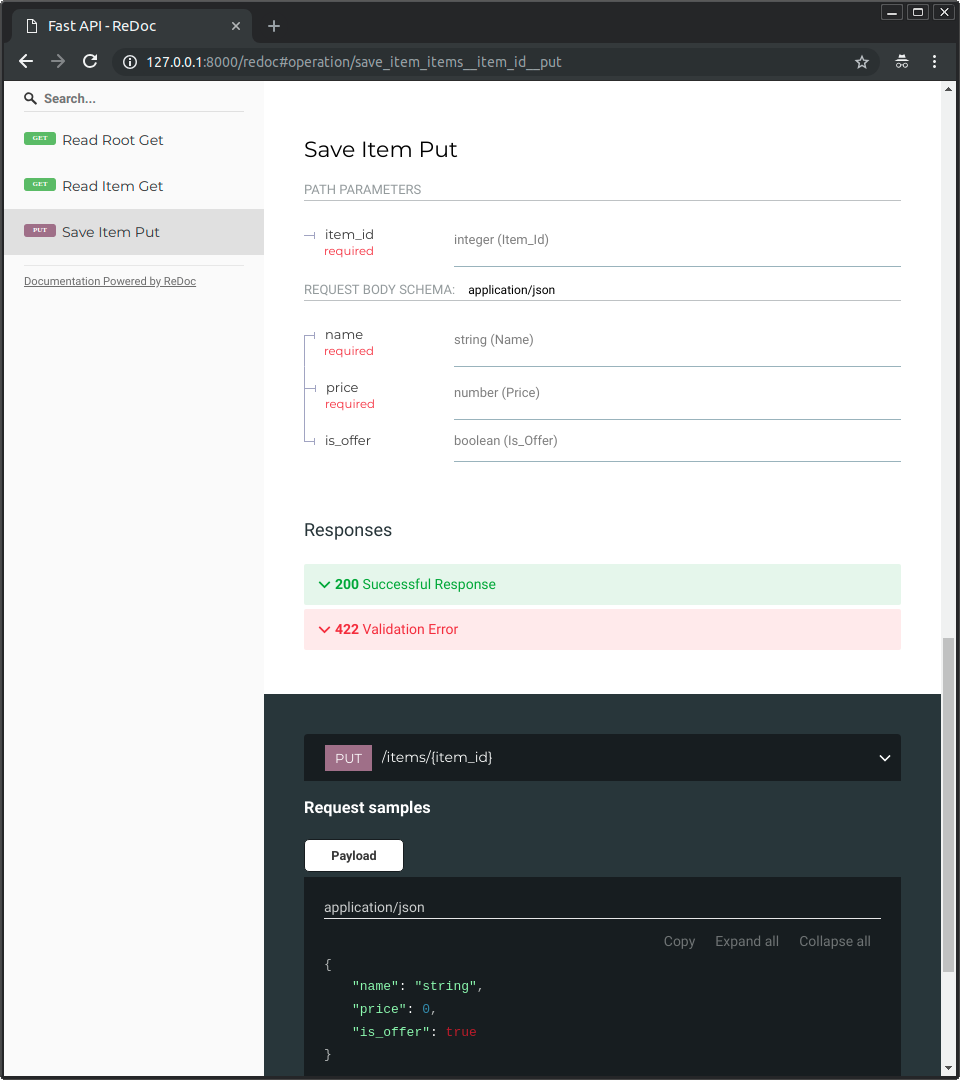- Sort Score
- Result 10 results
- Languages All
Results 11 - 20 of 1,169 for _parameters (0.28 sec)
-
docs/en/docs/tutorial/query-params-str-validations.md
# Query Parameters and String Validations { #query-parameters-and-string-validations } **FastAPI** allows you to declare additional information and validation for your parameters. Let's take this application as example: {* ../../docs_src/query_params_str_validations/tutorial001_py310.py hl[7] *}Registered: Sun Sep 07 07:19:17 UTC 2025 - Last Modified: Sun Aug 31 09:15:41 UTC 2025 - 17.2K bytes - Viewed (0) -
docs/en/docs/tutorial/query-param-models.md
# Query Parameter Models { #query-parameter-models } If you have a group of **query parameters** that are related, you can create a **Pydantic model** to declare them. This would allow you to **re-use the model** in **multiple places** and also to declare validations and metadata for all the parameters at once. 😎 /// note This is supported since FastAPI version `0.115.0`. 🤓 ///Registered: Sun Sep 07 07:19:17 UTC 2025 - Last Modified: Sun Aug 31 09:15:41 UTC 2025 - 2.2K bytes - Viewed (0) -
docs/en/docs/tutorial/path-params-numeric-validations.md
# Path Parameters and Numeric Validations { #path-parameters-and-numeric-validations } In the same way that you can declare more validations and metadata for query parameters with `Query`, you can declare the same type of validations and metadata for path parameters with `Path`. ## Import Path { #import-path } First, import `Path` from `fastapi`, and import `Annotated`: {* ../../docs_src/path_params_numeric_validations/tutorial001_an_py310.py hl[1,3] *}Registered: Sun Sep 07 07:19:17 UTC 2025 - Last Modified: Sun Aug 31 09:15:41 UTC 2025 - 6.2K bytes - Viewed (0) -
src/main/java/org/codelibs/fess/entity/DataStoreParams.java
} /** * Stores a parameter value with the specified key. * * @param key the parameter key, must not be null * @param value the parameter value, may be null */ public void put(final String key, final Object value) { params.put(key, value); } /** * Retrieves a parameter value by key. * * @param key the parameter key to look upRegistered: Thu Sep 04 12:52:25 UTC 2025 - Last Modified: Thu Jul 17 08:28:31 UTC 2025 - 5.8K bytes - Viewed (0) -
docs/en/docs/tutorial/body.md
/// ## Request body + path parameters { #request-body-path-parameters } You can declare path parameters and request body at the same time. **FastAPI** will recognize that the function parameters that match path parameters should be **taken from the path**, and that function parameters that are declared to be Pydantic models should be **taken from the request body**.Registered: Sun Sep 07 07:19:17 UTC 2025 - Last Modified: Sun Aug 31 10:58:56 UTC 2025 - 7.1K bytes - Viewed (0) -
README.md
* The alternative documentation will also reflect the new query parameter and body:  ### Recap { #recap } In summary, you declare **once** the types of parameters, body, etc. as function parameters. You do that with standard modern Python types.Registered: Sun Sep 07 07:19:17 UTC 2025 - Last Modified: Sun Aug 31 15:19:49 UTC 2025 - 24.3K bytes - Viewed (0) -
src/main/java/org/codelibs/fess/entity/RequestParameter.java
import java.util.Arrays; /** * Entity class representing a request parameter with a name and associated values. * This class encapsulates HTTP request parameters that can have multiple values, * such as query parameters, form parameters, or other request-related data. * * <p>This class is immutable and thread-safe. Once created, the parameter name * and values cannot be modified.</p> * */ public class RequestParameter {Registered: Thu Sep 04 12:52:25 UTC 2025 - Last Modified: Thu Jul 17 08:28:31 UTC 2025 - 2.4K bytes - Viewed (0) -
src/main/java/org/codelibs/fess/mylasta/action/FessMessages.java
/** * Add the created action message for the key 'constraints.Size.message' with parameters. * <pre> * message: The size of {item} must be between {min} and {max}. * </pre> * @param property The property name for the message. (NotNull) * @param min The parameter min for message. (NotNull) * @param max The parameter max for message. (NotNull) * @return this. (NotNull) */Registered: Thu Sep 04 12:52:25 UTC 2025 - Last Modified: Sat Jul 05 02:36:47 UTC 2025 - 119.6K bytes - Viewed (0) -
docs/en/docs/tutorial/header-param-models.md
# Header Parameter Models { #header-parameter-models } If you have a group of related **header parameters**, you can create a **Pydantic model** to declare them. This would allow you to **re-use the model** in **multiple places** and also to declare validations and metadata for all the parameters at once. 😎 /// note This is supported since FastAPI version `0.115.0`. 🤓 ///Registered: Sun Sep 07 07:19:17 UTC 2025 - Last Modified: Sun Aug 31 09:15:41 UTC 2025 - 2.6K bytes - Viewed (0) -
docs/en/docs/tutorial/path-params.md
Registered: Sun Sep 07 07:19:17 UTC 2025 - Last Modified: Sun Aug 31 10:29:01 UTC 2025 - 9.3K bytes - Viewed (0)